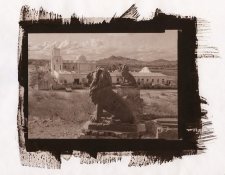Herzeleid
Member
I have done a few experiments with salt print. So far so good everything seems fine. I can have decent prints no more darkening or bad brush strokes after switching to glass rod coating.
I am using the formula from Christopher James' book:
1000ml water
8 gr gelatin
20 gr sodium chloride
18 gr sodium citrate
and %10 percent silver nitrate solution.
But
I want a bit of more contrast, without turning to potassium dichromate option for now.
In the book it is mentioned that decreasing the sodium citrate or eliminating all together will increase contrast.
Which way I should go? Do you add sodium citrate at all? Or do you prefer lesser amount of sodium citrate.
What is your opinion I wanted to know before I start wasting precious silver nitrate
Oh and btw I would really like to have more reddish purplish tones, any tips?
I am using the formula from Christopher James' book:
1000ml water
8 gr gelatin
20 gr sodium chloride
18 gr sodium citrate
and %10 percent silver nitrate solution.
But
I want a bit of more contrast, without turning to potassium dichromate option for now.
In the book it is mentioned that decreasing the sodium citrate or eliminating all together will increase contrast.
Which way I should go? Do you add sodium citrate at all? Or do you prefer lesser amount of sodium citrate.
What is your opinion I wanted to know before I start wasting precious silver nitrate

Oh and btw I would really like to have more reddish purplish tones, any tips?




